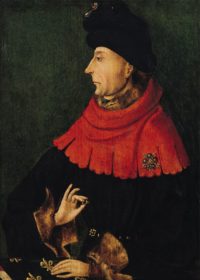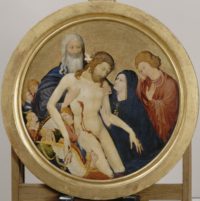Johan Maelwael, also known by the French version of his name Jean Malouel, was born in Nijmegen in around 1365. Nijmegen was part of the Duchy of Guelders then (now the province of Gelderland in the Netherlands) and had just joined the Hanseatic League in 1364. The prosperity that came with the increase in trade and commerce engendered a flourishing of the arts. Johan came from an artistic family — his father and uncle were successful artists — and he trained in his father Willem’s workshop from an early age.
He started his professional career as a painter of heraldic imagery at the court of the Dukes of Guelders in his hometown of Nijmegen. That experience proved desirable and portable, and in 1396 he moved to Paris where he specialized in painting heraldic and armorial images for Isabeau of Bavaria, Queen of France. Isabeau was a great patron of the arts who during this period had built something of a shadow court thanks to her husband’s increasingly frequent bouts of mental illness. (Whenever the King succumbed to one of his spells, which lasted months at a time, he did not recognize Isabeau and demanded that strange woman be removed from his presence.)
 Maelwael’s work for the Queen lasted no more than a year, and by the summer of 1397 Maelwael was in Dijon, capital of the Duchy of Burgundy, where he was appointed court painter to Philip the Bold, Duke of Burgundy. The appointment came with the rank of valet de chambre and a hefty salary. Maelwael would keep the job even after Philip’s death in 1404, remaining court painter to his son and successor John the Fearless.
Maelwael’s work for the Queen lasted no more than a year, and by the summer of 1397 Maelwael was in Dijon, capital of the Duchy of Burgundy, where he was appointed court painter to Philip the Bold, Duke of Burgundy. The appointment came with the rank of valet de chambre and a hefty salary. Maelwael would keep the job even after Philip’s death in 1404, remaining court painter to his son and successor John the Fearless.
At the Burgundy court, Maelwael again painted heraldic images on banners, pennants, flags and armour, but he also went further afield. Among other works, the dukes commissioned large-scale murals, devotional panel paintings, elaborate altarpieces for the Carthusian monastery of Champmol where Philip’s tomb was located, and the painting and gilding of sculptures. He experimented with new approaches and pioneered what would become known as the International Gothic style.
 The greatest surviving example of this is a tondo known as La Grande Pietà, a tempera on wood panel painting that many art historians consider to be the first proper tondo of the Renaissance. The iconography is not typical of later Renaissance pietas because in addition to the dead Christ held by his disconsolate mother Mary, God the Father is also in the picture, holding up the body of his sacrificed Son. Two angels help hold up the body, and a four more balance out the composition on the left side, adding splashes of color and a variety of anguished facial expressions. On the far right is a facepalming St. John.
The greatest surviving example of this is a tondo known as La Grande Pietà, a tempera on wood panel painting that many art historians consider to be the first proper tondo of the Renaissance. The iconography is not typical of later Renaissance pietas because in addition to the dead Christ held by his disconsolate mother Mary, God the Father is also in the picture, holding up the body of his sacrificed Son. Two angels help hold up the body, and a four more balance out the composition on the left side, adding splashes of color and a variety of anguished facial expressions. On the far right is a facepalming St. John.
On the back of the round is an example of the specialty that launched Maelwael’s illustrious career: the coat of arms of Philip the Bold of Burgundy. This suggests the painting was commissioned by Philip before his death, and the unusual combination of a pieta and the Holy Trinity suggests it may have been intended for the Burgundy tombs at Champmol since the monastery was dedicated to the Trinity and the ducal family also evinced a particular devotion to the Trinity.
Besides the imagery, Maelwael also included unusual features in the technical aspects of the painting. The frame of the tondo was carved out of the wood panel, something I don’t recall seeing in any other example of the form. His use of transparent glazes over the tempera was also ground-breaking. Early Netherlandish master Jan van Eyck, who a decade after Maelwael’s death followed in his footsteps as painter to the Duke of Burgundy (Philip the Bold, in his time), would take those transparent glazes and run with them.
One of the reasons the tondo is so special is that it is one of very few extant works that can be conclusively attributed to Johan Maelwael. Acquired by the Louvre in 1864, La Grande Pietà is one of the treasures of the museum’s early Flemish collection. It hasn’t left Paris since 1962, but come this fall, the greatest surviving masterpiece of the first painter of the Northern Renaissance will be heading to the Netherlands for the first time in its existence when it goes on display at the Rijksmuseum.
At the Burgundian court, Maelwael painted flags, banners and armour; he designed patterns for fabrics; he executed large religious paintings; he created refined miniatures in illuminated manuscripts; he decorated sculptures with gold-leaf and color and he painted small devotional pieces and portraits. Around 1400 Maelwael introduced his three talented nephews as miniature painters in France: the legendary Limbourg brothers Herman, Johan and Paul.
For the first time, Maelwael’s paintings will be exhibited alongside medieval art treasures, manuscripts, precious metalwork and sculpture – from among others, the Musée du Louvre in Paris, the MET in New York and the Gemäldegalerie in Berlin. Maelwael’s paintings will be juxtaposed not only with the sculpture of his contemporaries Claus Sluter and Claes van Werve, but also with the richly decorated illuminated manuscripts of the Limbourg brothers.
The Johan Maelwael exhibition will run at the Rijksmuseum from October 6th, 2017, through January 7th, 2018.
That’s really cool 🙂
One thing though: people from The Netherlands are called Dutch not Netherlandish (that word just makes me wince)
It does the same with me, Magical, but don’t tell my cousin’s Frisian in-laws they’re Dutch. You’ll get a clog to the head.
Would 14th century ‘Nederlanders’, from places like Ghent, have known what ‘Dutch’ is supposed to mean ?
They probably wouldn’t: There is e.g. ‘North Brabant’ in NL (Dutch) and there is the ‘Province of Brabant’ in BE (of which a part is Flemish) and then Flanders and all othe rest.
What I just don’t get, is how this could be all Dutch to you ! 😆
Frisians are a whole different people, they speak something that my brain can understand but it can’t classify as a language. The best way to describe it is that it’s part way between Dutch, English and something else. Since I’m a native English and Dutch speaker (long story) it somehow is something I understand, though can’t speak. I’ll throw the clog back and give them some Weduwe Joustra, we’ll be friends in no time 🙂
They would probably not but then the country was referred to as many things, and has been many sizes over the years, then and still is, although the use of most alternate versions is getting less frequent by the year.
They should never have annexed Brabant into Belgium, look at all the issues it’s caused! (though admittedly they stick to bickering rather than all out war)
I happen to live in NB actually – and was born there, though somewhat closer to the border than where I live now 😛
So yeah… it is all Dutch to me 😉
Myself, I spent some time in SB in BE (and the best parts of Zeeland). As you will know, but some others may not:
———-
“Over time, English-speaking people used the word Dutch to describe people from both the Netherlands and Germany. At that point in time, in the early 1500s, the Netherlands and parts of Germany, along with Belgium and Luxembourg, were all part of the Holy Roman Empire. Specifically the phrase ‘High Dutch’ referred to people from the mountainous area of what is now southern Germany. ‘Low Dutch’ referred to people from the flatlands in what is now the Netherlands. Within the Holy Roman Empire, the word ‘Netherlands’ was used to describe people from the low-lying (nether) region (land) [‘Low Countries’]”
———-
Thus, with ‘High Dutch’ Greetings :hattip: